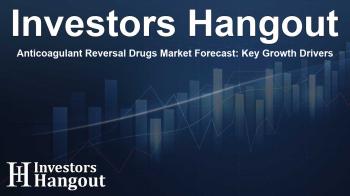Anticoagulant Reversal Drugs Market Forecast: Key Growth Drivers

Anticoagulant Reversal Drugs Market Forecast: Key Growth Drivers
The global anticoagulant reversal drugs market is on track for substantial growth, expected to increase by USD 1.27 billion from 2025 to 2029. This surge, projected by market studies, highlights the critical role of innovative therapies like Andexanet Alfa and Idarucizumab in addressing challenges related to bleeding risks associated with anticoagulant therapies. The increasing prevalence of coagulation disorders, coupled with an enhanced focus on patient care in healthcare sectors, underpins this expansive market evolution.
Market Dynamics and Growth Opportunities
As healthcare systems continue to evolve, the anticoagulant reversal drugs market is poised for significant expansion. The demand for drugs that can counteract the effects of anticoagulants is becoming increasingly vital, particularly in hospitals where emergency treatments are required. Cardiovascular conditions, especially atrial fibrillation and thromboembolic disorders, are central to this growth, necessitating effective reversal agents. The market is driven by several factors, including advancements in medical research and development aimed at producing safer and more efficient reversal medications.
Emerging Trends in Anticoagulation Therapy
The introduction of advanced anticoagulant reversal agents is reshaping the treatment landscape. Notably, innovative solutions focused on minimizing bleeding risks are gaining traction globally. The ongoing challenges posed by antimicrobial resistance further stress the importance of effective anticoagulant management. In this respect, hospital pharmacies play a pivotal role in ensuring these medications are readily available and effectively utilized to improve patient outcomes.
Regional Growth Insights
A considerable part of the market growth is observed in the Asia Pacific region. With an aging population and a rise in related health conditions, countries are adapting their healthcare infrastructures to meet this increasing demand. The growth in markets like China and India is particularly promising, driven by government initiatives to enhance access to essential medications. This trend reflects the broader global shift towards improved healthcare services and management of anticoagulant therapies.
Addressing Market Challenges
While the growth potential in the anticoagulant reversal drugs market is significant, various challenges persist. Regulatory hurdles and stringent approval processes can impede the introduction of new therapies. Additionally, the high costs associated with these drugs may restrict accessibility for certain populations. Meeting regulatory compliance and ensuring affordability are critical elements that pharmaceutical companies must address to capture market opportunities effectively.
Innovation and R&D Focus
Continuous innovation remains at the forefront as pharmaceutical companies seek to enhance the efficacy of anticoagulant reversal agents. Research into novel agents, including Factor VIIa and thrombin, demonstrates the industry’s commitment to addressing patient needs and optimizing treatment protocols. Moreover, the global health landscape emphasizes the necessity for ongoing collaboration between healthcare providers and pharmaceutical manufacturers to ensure patient safety and drug efficacy.
Anticipated Future Developments
Looking ahead, the anticoagulant reversal market is expected to witness notable developments. The increasing complexity of anticoagulant therapies necessitates the constant evolution of monitoring and reversal strategies. The integration of AI and advanced analytics into healthcare practices promises to further enhance drug utilization and patient safety. As the focus shifts towards personalized medicine, the demand for tailored anticoagulation therapies will undoubtedly influence market trends moving forward.
Frequently Asked Questions
What is driving the growth of the anticoagulant reversal drugs market?
The growth is primarily driven by the increasing prevalence of coagulation disorders and innovations in drug development aimed at minimizing bleeding risks in patients.
What challenges does the anticoagulant reversal drugs market face?
Challenges include regulatory hurdles, the high cost of medications, and the need for stringent safety measures and monitoring processes.
How are emerging economies impacting the anticoagulant reversal drugs market?
Emerging economies, particularly in Asia Pacific, are experiencing growth due to improved healthcare infrastructure and rising demand for effective antibiotic therapies.
What role do hospital pharmacies play in this market?
Hospital pharmacies are crucial for managing anticoagulant medications, ensuring their availability, and providing education for effective use in emergency situations.
What innovations are on the horizon for anticoagulant therapies?
Future innovations may include the development of novel reversal agents and enhanced monitoring technologies to improve patient outcomes and treatment protocols.
About Investors Hangout
Investors Hangout is a leading online stock forum for financial discussion and learning, offering a wide range of free tools and resources. It draws in traders of all levels, who exchange market knowledge, investigate trading tactics, and keep an eye on industry developments in real time. Featuring financial articles, stock message boards, quotes, charts, company profiles, and live news updates. Through cooperative learning and a wealth of informational resources, it helps users from novices creating their first portfolios to experts honing their techniques. Join Investors Hangout today: https://investorshangout.com/
Disclaimer: The content of this article is solely for general informational purposes only; it does not represent legal, financial, or investment advice. Investors Hangout does not offer financial advice; the author is not a licensed financial advisor. Consult a qualified advisor before making any financial or investment decisions based on this article. The author's interpretation of publicly available data shapes the opinions presented here; as a result, they should not be taken as advice to purchase, sell, or hold any securities mentioned or any other investments. The author does not guarantee the accuracy, completeness, or timeliness of any material, providing it "as is." Information and market conditions may change; past performance is not indicative of future outcomes. If any of the material offered here is inaccurate, please contact us for corrections.
